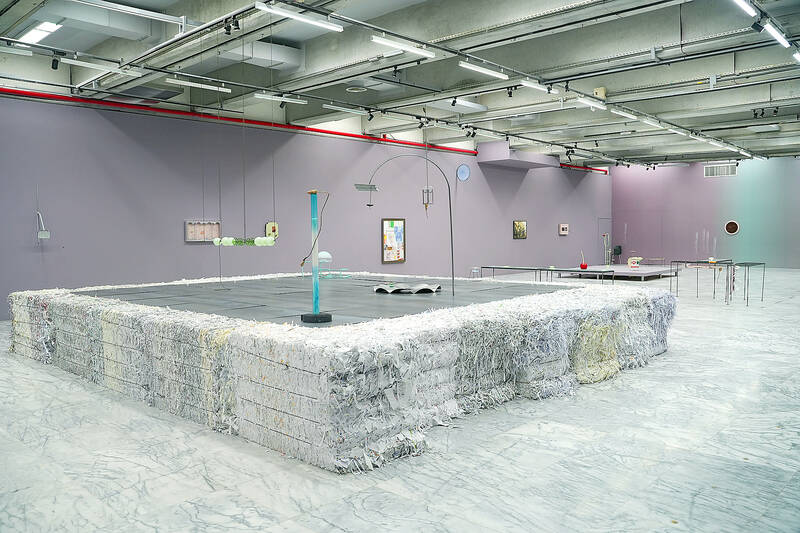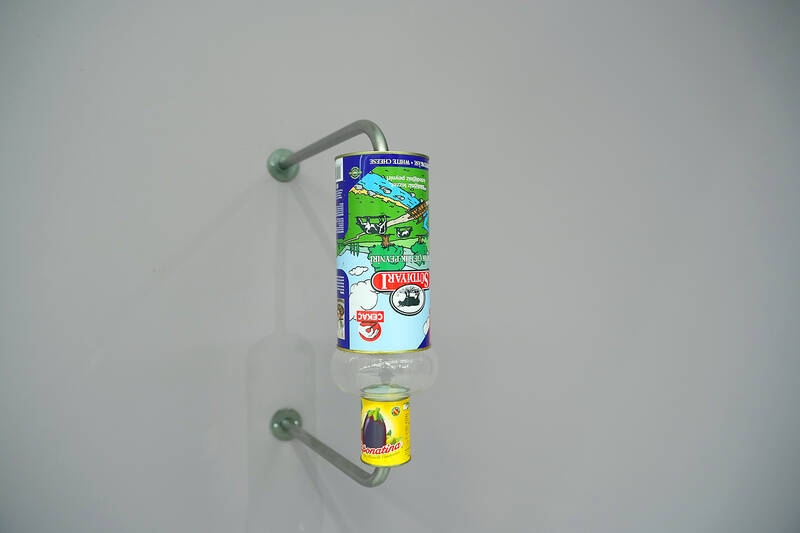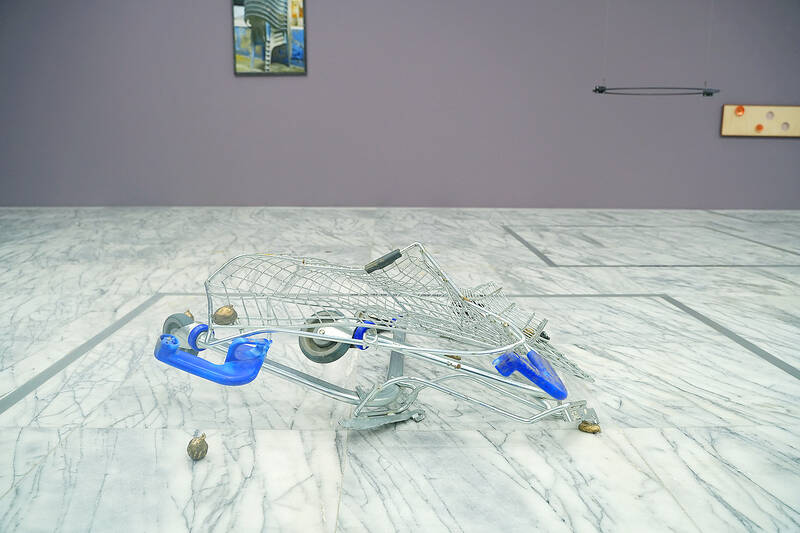On the lowest floor of the Taipei Fine Arts Museum (TFAM), a large room contains household items from coffee cans and wrapping paper to a mangled shopping cart. This is Lili Deli, the latest exhibition by multi-disciplinary artist Steph Huang (黃麗音).
The London-based Huang deftly blends painting, photography and sculpture to comment on mass production, commerce and consumerism.
There are platforms the size of small cars made entirely of shredded paper, a cherry made of hand-blown glass, a painting of a shopping cart drowning as though it is part of a Monet painting and more.

Photo: Lery Hiciano, Taipei Times
THROW-AWAY CULTURE
Huang has had several exhibitions satirizing and lampooning our contemporary obsession with buying more than we need and wasting more than the planet can handle.
“I am always aware of capitalism and consumerism in my work by engaging with materials from the capitalist world,” Huang told the Taipei Times.

Photo: Lery Hiciano, Taipei Times
In particular, she focuses on how speed, efficiency and affordability are prioritized in our society.
Upon walking into Lili Deli, visitors are greeted by a large platform of shredded paper with several art pieces on top of it, including Ride the Wave, made out of a horseradish root tube.
On another platform, a repurposed coffee can from the Netherlands and a human-sized paper clip stand tall, divorced from their original context.

Photo: Lery Hiciano, Taipei Times
URBAN DETRITUS
Huang describes her process as actively seeking out items left behind in urban areas, then gathering them in her studio, “waiting for their moment.”
What ties all these objects together? They once mattered, or functioned, or served some purpose far removed from being centerpieces at an art exhibit in Taipei — their commercial usefulness expiring, to be reimagined as part of an ongoing commentary on the need to consciously reconsider our own consumption habits.
Each piece is ambiguous yet familiar, readily willing to accept a viewer’s projections.
The shopping cart, dug out of a landfill in Scotland, looks like one that anyone would use in a supermarket, and the can of coffee grounds evokes memories of grandma with her morning cup of joe.
Yet each piece, by virtue of its placement in the gallery is puzzling, cryptic and obscure in its meaning.
It is strange to see household items in such a place, to try and figure out what type of household the item already came from or, in some cases, deduce what item it was and what its original purpose could have been.
“These works hold the potential to resonate with a wide audience, as many of the works are transformations of trivial day-to-day living experiences,” Huang said.
At the same time, she says that different countries where her work has been shown lead to different audience reactions, a “gap.” One work that is under construction is Lili Deli’s Tower of Freebies Project, where visitors are invited to bring unwanted items from home and deposit them to create a makeshift, collaborative monument.
At the end of the exhibition’s run in June, the tower’s items will then be distributed to interested parties, who can hopefully find more use or meaning in them than those who first abandoned them.
“I would love to see the tower reach its full potential,” she said.

A vaccine to fight dementia? It turns out there may already be one — shots that prevent painful shingles also appear to protect aging brains. A new study found shingles vaccination cut older adults’ risk of developing dementia over the next seven years by 20 percent. The research, published Wednesday in the journal Nature, is part of growing understanding about how many factors influence brain health as we age — and what we can do about it. “It’s a very robust finding,” said lead researcher Pascal Geldsetzer of Stanford University. And “women seem to benefit more,” important as they’re at higher risk of

March 31 to April 6 On May 13, 1950, National Taiwan University Hospital otolaryngologist Su You-peng (蘇友鵬) was summoned to the director’s office. He thought someone had complained about him practicing the violin at night, but when he entered the room, he knew something was terribly wrong. He saw several burly men who appeared to be government secret agents, and three other resident doctors: internist Hsu Chiang (許強), dermatologist Hu Pao-chen (胡寶珍) and ophthalmologist Hu Hsin-lin (胡鑫麟). They were handcuffed, herded onto two jeeps and taken to the Secrecy Bureau (保密局) for questioning. Su was still in his doctor’s robes at

Last week the Democratic Progressive Party (DPP) said that the budget cuts voted for by the China-aligned parties in the legislature, are intended to force the DPP to hike electricity rates. The public would then blame it for the rate hike. It’s fairly clear that the first part of that is correct. Slashing the budget of state-run Taiwan Power Co (Taipower, 台電) is a move intended to cause discontent with the DPP when electricity rates go up. Taipower’s debt, NT$422.9 billion (US$12.78 billion), is one of the numerous permanent crises created by the nation’s construction-industrial state and the developmentalist mentality it

Experts say that the devastating earthquake in Myanmar on Friday was likely the strongest to hit the country in decades, with disaster modeling suggesting thousands could be dead. Automatic assessments from the US Geological Survey (USGS) said the shallow 7.7-magnitude quake northwest of the central Myanmar city of Sagaing triggered a red alert for shaking-related fatalities and economic losses. “High casualties and extensive damage are probable and the disaster is likely widespread,” it said, locating the epicentre near the central Myanmar city of Mandalay, home to more than a million people. Myanmar’s ruling junta said on Saturday morning that the number killed had